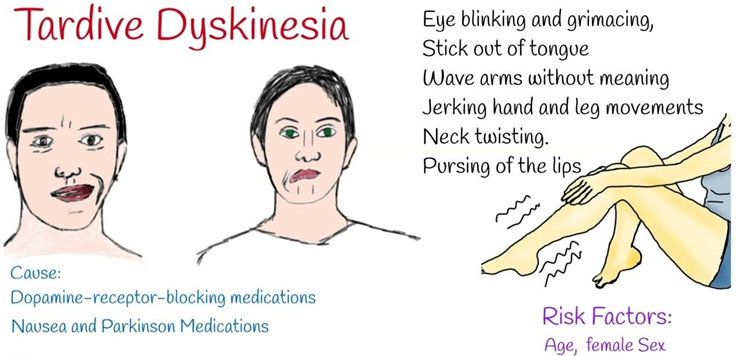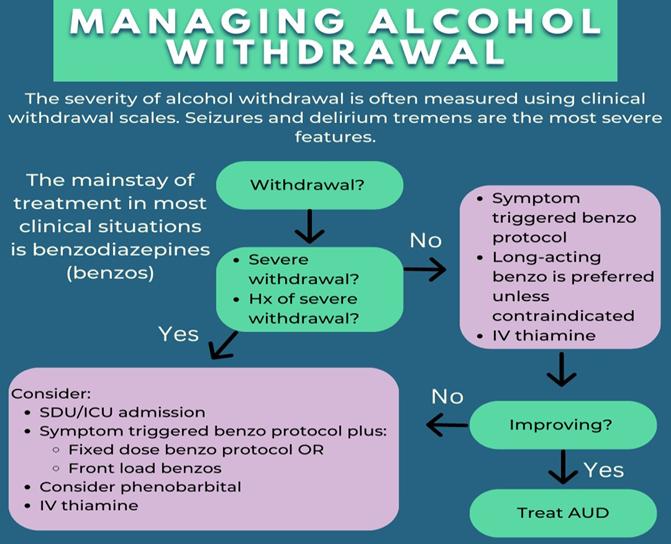A nurse is collecting data from a client who has schizophrenia and recently stopped taking chlorpromazine after 8 years. The nurse notes choreiform movements, lip smacking, and spastic facial distortions. The nurse should document these findings as indicating which of the following conditions?
Akathisia
Dystonia
Pseudoparkinsonism
Tardive dyskinesia
The Correct Answer is D
A. Akathisia refers to a subjective feeling of restlessness and an objective inability to sit still.
It's characterized by a need to move constantly and is not typically associated with choreiform movements, lip smacking, or spastic facial distortions.
B. Dystonia involves sustained or intermittent muscle contractions leading to abnormal postures or twisting movements. It typically presents with muscle spasms, not choreiform movements or lip smacking.
C. Pseudoparkinsonism refers to a collection of symptoms that resemble Parkinson's disease, such as tremor, bradykinesia, rigidity, and postural instability. It does not typically involve choreiform movements or lip smacking.
D. Tardive dyskinesia is a movement disorder characterized by involuntary, repetitive movements of the face and body, including choreiform movements (rapid, jerky movements), lip smacking, and spastic facial distortions. It often develops after long-term use of antipsychotic medications like chlorpromazine and can persist even after discontinuation of the medication.

Nursing Test Bank
Naxlex Comprehensive Predictor Exams
Related Questions
Correct Answer is A
Explanation
A. Azithromycin is an antibiotic commonly used to treat infections such as chlamydia. While it's generally well-tolerated, it can rarely cause serious side effects such as allergic reactions or severe skin reactions. Sore throat or fever may indicate such adverse effects, and patients
should be instructed to contact their healthcare provider immediately if they experience these symptoms.
B. Dark yellow or orange urine is not a typical side effect of azithromycin. It can be caused by drugs such as rifampin.
C. Taking azithromycin with an antacid is generally not necessary and may interfere with the absorption of the medication. It's usually recommended to take azithromycin on an empty stomach, at least 1 hour before or 2 hours after meals, unless otherwise directed by a healthcare provider.
D. Bleeding gums are not a common side effect of azithromycin. If a patient experiences unusual bleeding or bruising, they should seek medical attention, but this symptom is not specifically associated with azithromycin use.
Correct Answer is D
Explanation
A. Methadone is an opioid agonist primarily used for the management of opioid dependence and chronic pain. It is not indicated for the treatment of alcohol withdrawal or delirium.
B. Acamprosate is a medication used to support abstinence in individuals who have recently stopped drinking alcohol. It is not typically used to manage acute alcohol withdrawal symptoms such as delirium tremens.
C. Disulfiram is a medication used as an aversive therapy to deter alcohol consumption by causing unpleasant reactions (e.g., flushing, nausea, vomiting) when alcohol is ingested. It is not indicated for the treatment of alcohol withdrawal or delirium.
D. Lorazepam is a benzodiazepine commonly used to manage alcohol withdrawal symptoms, including delirium tremens. It acts by enhancing the inhibitory effects of gamma- aminobutyric acid (GABA) in the central nervous system, thereby reducing the symptoms of alcohol withdrawal such as seizures.

Whether you are a student looking to ace your exams or a practicing nurse seeking to enhance your expertise , our nursing education contents will empower you with the confidence and competence to make a difference in the lives of patients and become a respected leader in the healthcare field.
Visit Naxlex, invest in your future and unlock endless possibilities with our unparalleled nursing education contents today
Report Wrong Answer on the Current Question
Do you disagree with the answer? If yes, what is your expected answer? Explain.
Kindly be descriptive with the issue you are facing.
